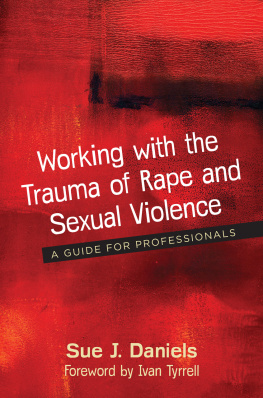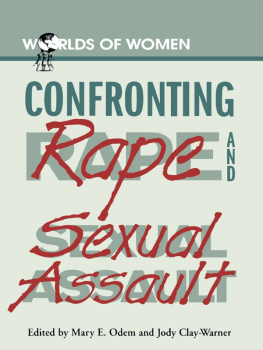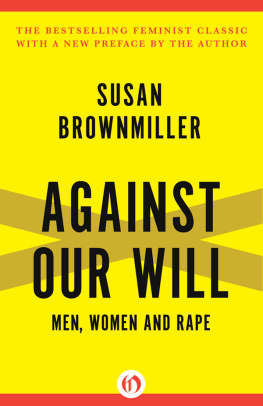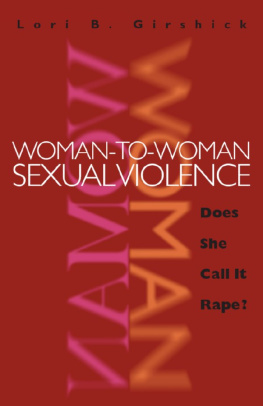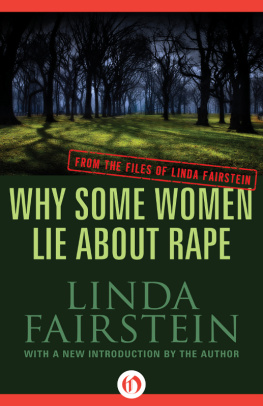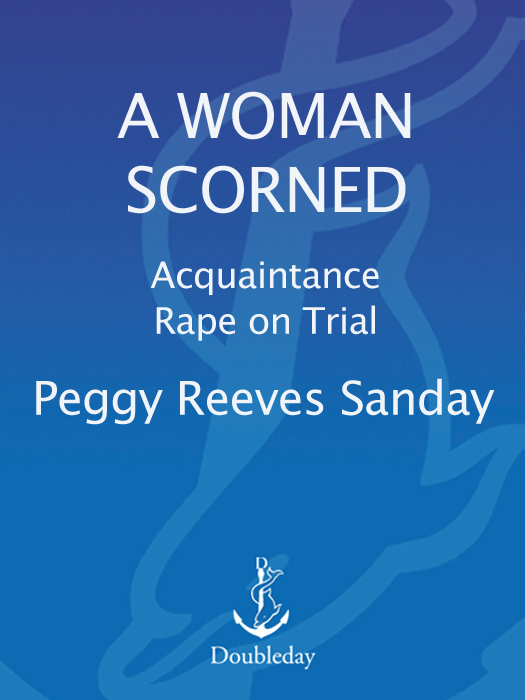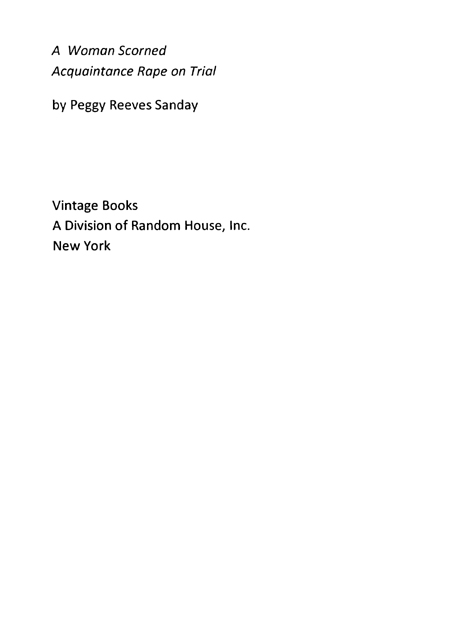by the same author
A NTHROPOLOGY AND THE P UBLIC I NTEREST :
F IELDWORK AND T HEORY
F EMALE P OWER AND M ALE D OMINANCE :
O N THE O RIGINS OF S EXUAL I NEQUALITY
D IVINE H UNGER :
C ANNIBALISM AS A C ULTURAL S YSTEM
B EYOND THE S ECOND S EX
(edited with Ruth Gallagher Goodenough)
F RATERNITY G ANG R APE :
S EX , B ROTHERHOOD AND P RIVILEGE ON C AMPUS
FIRST VINTAGE BOOKS EDITION, JANUARY 2012
Copyright 1996 by Peggy Sanday
All rights reserved. Published in the United States by Vintage Books, a division of Random House, Inc., New York. Originally published in hardcover in slightly different form in New York by Doubleday in 1996, and subsequently published in paperback in California by University of California Press, Ltd., Berkeley, in 1997.
Authors Note: In keeping with the dictates of anthropological ethics, the names of the defendants in the St. Johns case have been abbreviated.
Vintage and colophon are registered trademarks of Random House, Inc.
eISBN: 978-0-307-80209-5
v3.1
Heavn has no Rage, like Love to Hatred turnd
Nor Hell a Fury, like a Woman scornd.
W ILLIAM C ONGREVE , The Mourning Bride (Act III. Scene I)
Why then, he was asked, did the woman press the case? The juror answered: What was that thing that Shakespeare said? Hell hath no fury like a woman scorned.
I NTERVIEW WITH S T . J OHNS JUROR . Newsday, J ULY 24, 1991
Each person has the right not only to decide whether to engage in sexual contact with another, but also to control the circumstances and character of that contact. No one, neither a spouse, nor a friend, nor an acquaintance, nor a stranger, has the right or the privilege to force sexual contact.
S UPREME C OURT OF N EW J ERSEY , 1992
We need to get away from wordless sex. The brain is the most powerful sexual organ. It works by being verbal. If your mind isnt in it, if your heart isnt in it, then your body doesnt respond.
A LYSIA T URNER , B ROWN U NIVERSITY S TUDENT , 1994
T O S ERGE AND J ULIE WITH LOVE
CONTENTS
2. B IRTH OF THE F ALSE A CCUSER :
T HE C ASE OF M ARGERY E VANS
3. T HE E NIGMA OF P URITAN S EXUALITY :
R APE IN E ARLY N EW E NGLAND
4. T HE N O -M EANS -Y ES D EFENSE :
R APE AT THE B IRTH OF THE N ATION
PREFACE TO THE PAPERBACK EDITION
Just say yes, he whispered. Just tell me yes, tell me yes. Say yes to me. Say yes, oh god say yes.
David Guterson, Snow Falling on Cedars
(New York: Vintage, 1995), 214
Words (are) unnecessary in love. But in spite of all she had said, he still saw love in her eyes. He believed her eyes more than he believed her words.
Hermann Hesse, Narcissus and Goldmund
(New York: Farrar, Straus and Giroux, 1968), 110
T HIS BOOK LOOKS AT THE HISTORY OF A MERICAN SEXUAL BEHAVIOR FROM the point of view of acquaintance rape. Human sexuality, I argue, sits on the precarious divide between biology and culture, between individualized sensations and cultural meanings; it is both physiological and preeminently social. By tying the frequency of reported acquaintance rape to popular sexual culture, which defines male sexual aggression as natural and puts a woman accuser on trial in the courtroom, this book demonstrates the power of culture in shaping sexual behavior.
Historically, Americans have been remarkably voluble about human sexuality, passing sex through the endless mill of speech in our theories and popular beliefs. But we have been remarkably silent when actually doing it. Rather than talking with our partners about our desires, we are likely to move ahead wordlessly, guided by nonverbal cuesa look in the eyes, a quiver of the lips, an intonation of the voice, a scent. Although such cues emanate from the body, because their meaning varies according to a partners interpretation, they are preeminently cultural.
Wordless sex is full of social consequences and meaning. For one thing, it carries the tremendous risks of unwanted pregnancy and sexually transmitted diseases. To mention just one of any number of social meanings, sometimes sex is played as a game of conquest. In this game the man who moves ahead without obtaining verbal consent acts as seducer, wielding power not just in the sexual activity itself but also in the boasts to his buddies about his latest sexual conquest. Some women go along with this social game because submitting wordlessly to a mans seduction allows them to maintain the illusion/appearance of sexual innocence. Other women feel violated if the sex is unwanted and against their will.
The term acquaintance rape was coined in the 1970s to distinguish rape involving strangers from forced, nonconsensual penetration involving people who know one another. Surveys conducted in the 1970s found that a high number of women answered affirmatively when asked if they had experienced nonconsensual sex, including rape. Since then, numerous surveys of local and national populations reveal that on average between 13 and 25 percent of the participating females report having been raped, usually by men they knew. Most of these surveys employ the legal definition of rape as nonconsensual penetration by the use of force or threat of force or the taking advantage of someone incapacitated by alcohol or drugs. One of the most respected national studies, published in 1992, found that acquaintance rape was a tragedy of youth, involving women below the age of twenty-one. The most recent study (1994), using a scientifically designed national probability sample and compared in its scope to the famous Kinsey studies of male and female sexual behavior, found that one-in-five women surveyed considered themselves to have been forced against their will to do something sexually.
This book places acquaintance rape within the context of the history of American sexual culture. I examine the testimony presented in high-profile court cases from Puritan times to the present against the background of popular sexual culture and unfolding theories of human sexuality. I analyze the boys will be boys explantation of acquaintance rape, arguing that our tendency to excuse male sexual aggression by reducing it to hormones gives males the power in the sexual game because it removes any responsibility for the sexual activity from the male and places it solely on the female. I chart how we have explained male and female sexuality to ourselves and then used these explanations in the courtroom to excuse male aggression and place women accusers on trial.
Rape is one of the few charges in the criminal justice system where reasonable doubt is induced not so much by the character of the evidence as by fantasies regarding the complainants motives for bringing charges. It is not uncommon for rape juries to overlook the prosecutions evidence of force in favor of the defenses suggestion that the accuser wanted it or that she brought charges because she was a woman scorned. The most recent high-profile acquaintance rape case, tried in November 1996, after this book was first published, fits a common pattern. In this case the defense argued that the accusers inhibitions had been released by the four small glasses of beer she drank at the party where she met the defendant, Alex Kelly. The young woman, barely sixteen and a virgin, met Kelly an hour before the alleged rape and was with him only because she needed a ride home and he offered to drive her. Thomas P. Puccio, best known for his defense of Claus von Bulow against the charge of attempting to murder his wife, argued that she wanted to have sex with Kelly because he was popular and handsome. He explained away the girls injuries as consistent with first-time sex and suggested that her charges were the inventions of a strict Catholic girl who chose to lose her virginity in the back of a car and then felt guilty the morning after. He argued that the pain of intercourse only increased her sense of having sinned. In his cross-examination, Puccio added the element of revenge, suggesting that the young woman was jealous because Kelly had a girlfriend and there was no future in the relationship.


